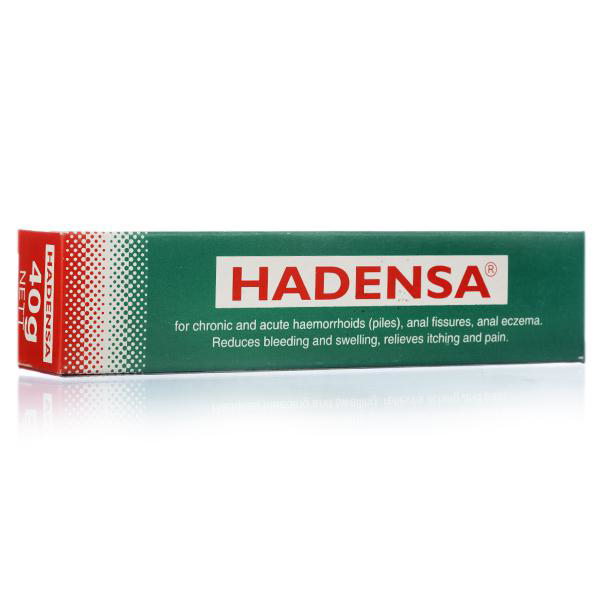Hadensa Ointment 40gm
$13.00 $10.00
Hadensa Ointment 40gm

Description
Hadensa ointment is used for the treatment of haemorrhoids (piles), anal fissures or anal fistula. It also relieves itching and pain and reduces bleeding or swelling in the affected area. It contains lignocaine, menthol and thymol as key ingredients which effectively relieves pain and imparts a cooling sensation. Lignocaine belongs to the group of medicines called local anesthetic agent that numbs the sensations of tissues. It blocks the generation and conduction of nerve impulse by increasing the threshold for electrical excitation in the nerve, by slowing propagation of the nerve impulse, and by reducing the rate of risk of action potential.
Menthol is known as a counterirritant which works by causing the skin to feel cool and then warm. This feeling on the skin distract you from feeling the aches/pains deeper in your muscles and joints. Thymol is an anesthetic and antiseptic which can relieve from pain and arrest the growth of unwanted microorganisms. Clean the affected area before use, if you are applying this medication to other mucous membranes or the skin and apply with clean hands. Apply the ointment with a sterile gauze pad for broken or burned skin. Wash your hands after each application. Before applying this medicine, talk to your doctor, if you have epilepsy, heart problems, liver problems, kidney problems or open wounds or infection where the ointment will be used. Your doctor can discuss with you the risks and benefits involved.
KEY COMPOSITION OF HADENSA OINTMENT:
Thymol
Menthol
Lignocaine
THERAPEUTIC USES OF HADENSA OINTMENT:
Used for the treatment of haemorrhoids (piles), anal fissures or anal fistula
Relieves itching and pain and reduces bleeding or swelling in the affected area
SIDE EFFECTS OF HADENSA OINTMENT 40GM:
COMMON:
Skin redness, rash or irritation
Mild tingling or burning sensation
SKIN IRRITATION OR RASH:
Avoid hot showers or baths because hot water can irritate the skin. Make sure to pat dry your skin after a bath or shower. Do not rub or scratch the affected area. Leave the skin exposed to the air as much as possible. Do not use perfumed soaps or deodorants. Water containing chlorine can make most skin problems worse, so avoid swimming. Avoid excessive sun exposure.
SAFETY ADVICE:
Always apply this medicine as directed by your physician.
It is for external use only.
If you are applying this medication to mucous membranes or the skin, clean the affected area before use, and apply with clean hands as directed.
For broken or burned skin, you may apply the ointment with a sterile gauze pad.
Wash your hands after each application.
Do not apply this medicine if you are allergic to any of its ingredients.
Before applying this medicine, talk to your doctor, if you have epilepsy, heart problems, liver problems, kidney problems, open wounds or infection where the ointment will be used or malignant hyperthermia (dangerously high body temperature).
Hadensa ointment should be used with caution in pregnant or breastfeeding women. Consult your doctor before using.
This medicine is not recommended for use in children unless prescribed by a doctor.
INTERACTIONS:
Talk to your doctor, if you are taking,
Medicines used to treat irregular heartbeat (e.g. amiodarone and mexiletine)
Medicines used to lower high blood pressure (e.g. betablockers)
Medicines used to treat epilepsy or fits (e.g. phenytoin, phenobarbitone, primidone or carbamezapine)
Cimetidine (a medicine used to treat reflux and ulcers)
MORE INFORMATION:
Keep out of reach of children.
Store in cool, dry place at a temperature not exceeding 30°C.
FAQs ABOUT HADENSA OINTMENT 40GM:
Q: What are the uses of Hadensa ointment?
A: It is used for the treatment of haemorrhoids (piles), anal fissures or anal fistula. It also relieves itching and pain and reduces bleeding or swelling in the affected area.
Q: Can Hadensa ointment be used in children?
A: This medicine is not recommended for use in children unless prescribed by a doctor.
Q: How to use Hadensa ointment?
A: If you are applying this medication to mucous membranes or the skin, clean the affected area before use, and apply with clean hands as directed. For broken or burned skin, you may apply the ointment with a sterile gauze pad. Wash your hands after each application.
Be the first to review “Hadensa Ointment 40gm” Cancel reply
Related products
Haemorrhoid
Haemorrhoid
Haemorrhoid
Haemorrhoid
Haemorrhoid
Haemorrhoid
Haemorrhoid
Haemorrhoid












Reviews
There are no reviews yet.